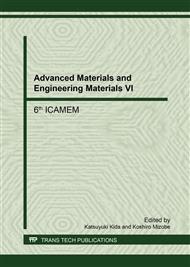p.259
p.264
p.269
p.275
p.280
p.284
p.288
p.295
p.301
Ferrite-Martensite Dual Phase Treatment of AISI 1040 Steel and Mechanical Characterization
Abstract:
The present work is focused on the characteristics of dual phase (Ferrite-Martensite) medium carbon steel (AISI1040) austenized at different inter critical temperatures (750,770, and 790°C). AISI1040 is plain carbon steel with moderate strength and hardness. The machinability of the steel depends upon the balanced properties obtained by preferential control of phases (wt. % and type) by altering the room temperature structure. In this view, the dual phase is obtained by varying wt. % of ferrite and martensite structure in the steel and then subjected to bulk mechanical property (tensile, hardness, impact resistance and microstructure) analysis. As bought steel is subjected to normalizing treatment which is taken as datum for analysis. The dual phase structure obtained is then tempered to enhance the balanced properties. It was observed that hardness and tensile strength increases with low temperature tempering (260°C) compared to high temperature tempering (425°C) and impact resistance is excellent in high tempering temperature.
Info:
Periodical:
Pages:
280-283
Citation:
Online since:
August 2017
Authors:
Keywords:
Price:
Сopyright:
© 2017 Trans Tech Publications Ltd. All Rights Reserved
Share:
Citation:


